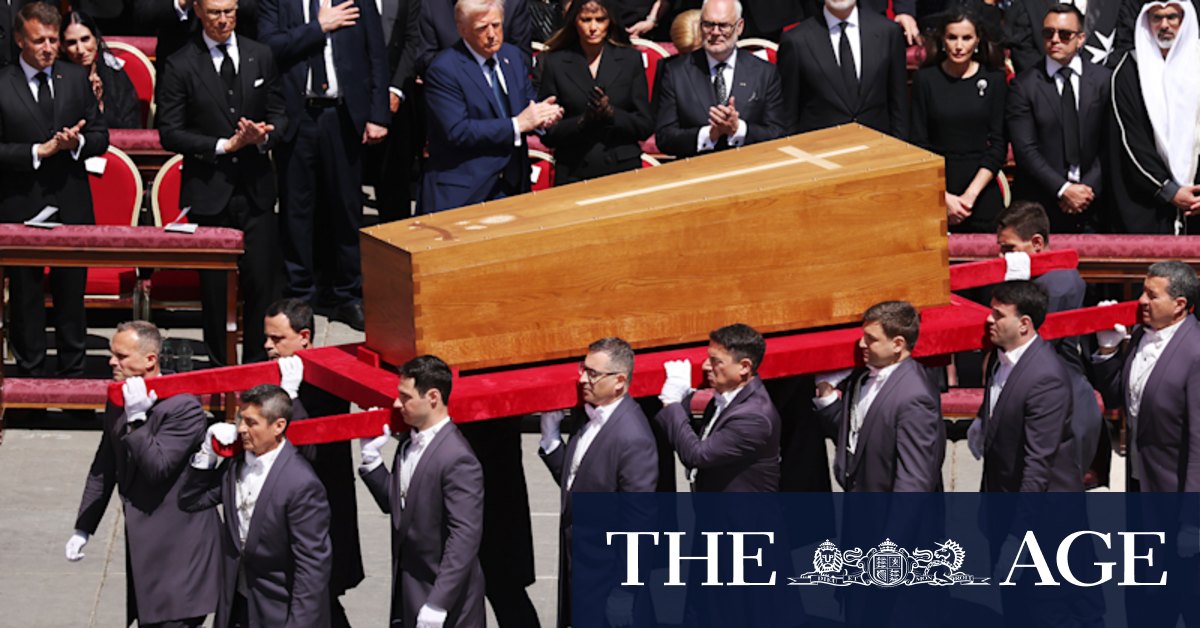NewsBeat
Cardinal appears to take subtle swipe at Donald Trump in powerful homily

Roads surrounding the Vatican have been blocked off, with security forces from across Italy on alert. Thousands of police officers have been stationed at key points throughout the city, and special measures implemented to ensure the safe passage of dignitaries.
The Vatican’s Swiss Guard, iconic in their colourful striped uniforms, have been closely co-ordinating with Italian law enforcement to maintain order. Thousands of police officers, alongside specialised security units, have been deployed, with fighter jets patrolling the skies above the city, ready to enforce a 24-hour no-fly zone. Police snipers and anti-drone technology have been stationed on rooftops along the Via della Conciliazione.

Cardinals attend the Mass at St Peter’s Basilica.Credit: Flavio Brancaleone
Over the past few days, 250,000 faithful queued outside St Peter’s Basilica, waiting for their moment to pay their respects to Francis. The atmosphere has been one of quiet reverence, with visitors from around the world filing past his coffin, which was placed on the ground in front of the Confessio altar. It was carried outside to the front of the basilica at the start of the funeral Mass.
Francis specifically requested to be laid to rest in a simple, humble manner, without any elaborate ceremonial trappings. The church says this reflected the core of his pontificate – a commitment to humility, service and connection with the marginalised of society.
The ceremony featured readings from the Acts of the Apostles, the Letter of St Paul to the Romans and the Gospel of John. The Mass was multilingual, with prayers offered in French, Arabic, Polish, Portuguese and Chinese, acknowledging the diverse global reach of Francis’ teachings.
World leaders were seated in French alphabetical order – an echo of a centuries-old tradition that honours the language of diplomacy. Only two leaders broke the sequence: the president of Italy, host to the Holy See, and the president of Argentina, homeland of the late pontiff. They sat front and centre.

Donald Trump and Melania Trump attend the funeral of Pope Francis.Credit: AP
The Sistine Chapel Choir sang during the Mass, offering a beautiful and poignant tribute to the Pope’s love of sacred music and liturgy.
Following the Mass, his coffin is being carried through the streets of Rome in a slow procession, passing by the ancient walls of the city and allowing Romans to pay their final respects. This route passes by many of the landmarks that were significant to Francis during his time in office, including the Vatican’s fortress-like walls and the icon of the Virgin Salus Populi Romani, which he often visited before and after his apostolic travels. The procession will culminate at the Papal Basilica of Saint Mary Major, where Francis requested to be buried.
The decision to bury Pope Francis outside the Vatican’s walls marks an unprecedented move in modern Church history. He is the first pope to be buried there since the 17th century – and the first in over 120 years to rest outside St Peter’s Basilica. His desire to be laid to rest near the people he served throughout his life, and especially the poor, reflects his deep connection with those outside the power structures of the Church.
Loading
The ceremony at Saint Mary Major will be a private affair, with only a small group of clergy and Church officials present to witness the Pope’s final interment. The Pope’s tomb will be located beneath the basilica, in a site that has already been consecrated.
Francis’ death marks the end of an era, one in which there was a sweeping transformation in the Church’s engagement with the modern world. But as the crowds gather in Rome to mourn his death and celebrate his life, it is clear that his legacy will continue to resonate for generations to come.
Get a note directly from our foreign correspondents on what’s making headlines around the world. Sign up for our weekly What in the World newsletter.
